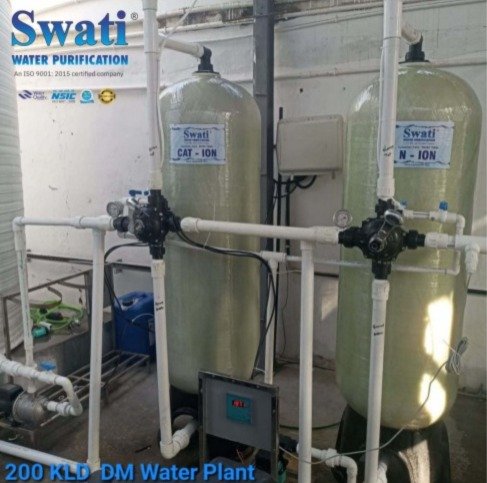Demineralization Plant
Swati Water Purification – Demineralization Plant Supplier, Demineralization Plant Manufacturer.

Demineralization Plant
A Demineralization (DM) Plant is designed to Remove Minerals, Salts and Other Impurities from Water, Typically to Produce Very Pure Water for Industrial Applications. The Primary Purpose of a DM Plant is to reduce the Total Dissolved Solids (TDS) in Water, Making is Suitable for Use in Processes Where High Purity is Required, Such As In Power Plants, Pharmaceuticals, Chemical Industries and Laboratories.
DM Water Plant Manufacturer
A Demineralization Plants Are Also Known As “Ion Exchange Plant,” “Mixed bed Demineralization Plant,” “Cation-Exchange Plant,” “Anion-Exchange Plant,” “Reverse Osmosis-Demineralization Plant,” “Deionized Water Plant,” “Demineralization Unit,” “Boiler Feed Water Demineralization Plant,” “Ultrapure Water plant,” “Softening and Demineralization Plant,” “Industrial Demineralization Plant,” “Water Purification System,” “Demineralized Water Production Unit,” “Desalination and Demineralization Plant,” “Demineralization and Softening Plant,” “Two Bed DM Plants,” “Mixed Bed DM Plants,” Also Known as a Deionization (DI) Plant is a Water Treatment System that Removes Dissolved Minerals and ions From Water.
We Are Manufacturers & Suppliers In Ahmedabad, Gandhinagar, Gujarat, India, Sanand GIDC, Mehsana, Vitthalapur, Mandal Bechraji Special Investment Region(MBSIR), Halol GIDC, Bavla Kerala GIDC, Dahej SIR & PCPIR(Petroleum, Chemicals and Petrochemicals Investment Region), Dholera SIR, GIDC Industrial Area(Gujarat Industrial Development Corporation), MIDC Industrial Area(Maharashtra Industrial Development Corporation), MPIDC Industrial Area(Madhya Pradesh Industrial Development Corporation), RIICO Industrial Area(Rajasthan State Industrial Development & Investment Corporation), PSIDC(Punjab State Industrial Development Corporation), SEZs Area(Special Economic Zones), SEEZ Area(Solar Energy Enterprises Zone) In Rajasthan, Peenya Industrial Area In Bengaluru(Bengalore, Karnataka).
Capacities: : 500 Liters per Hour (lph) to 100 Cubic Meters per Hour (M3/Hr) Or More.
Stages Of DM Water Plant / Demineralization Plant:
1. Ion Exchange Process
2. Cation Exchange
3. Anion Exchange
4. Production Of Pure Water
5. Mixed Bed Demineralization
Process Of DM Water Plant:
1. Water Inlet: Raw Water Enters the System and Undergoes Coarse Filtration and Activated Carbon Filtration to remove Large Particles and Organic Matter.
2. Ion Exchange: The Pre-treated Water Passes through the Cation and Anion Exchange Columns, Where the Harmful Ions are Exchanged for Hydrogen (H+) and Hydroxyl (OH- ) Ions.
3. Regeneration: Once the Ion-Exchange Resins Become Exhausted, They Need To Be Regenerated With Acid (For Cation Resins) and Alkali (For Anion Resins). This restores the resin’s Ability to Exchange Ions.
4. Final Output: The Demineralized Water, Which is Now Free Of Salts and Minerals, Exists the System and Can be Used For Industrial Purposes.
Applications Of Demineralization Plant In Different Industries:
- Power Generation: Boiler Feed Water: Demineralized Water is Essential For Boiler Operations to Avoid Scaling, Corrosion and Efficiency Loss.
- Pharmaceutical Industry: Injection Water and Purified Water: Demineralized Water is Used to Prepare Medicines, as is Ensures No Impurities are Present.
- Cooling Systems: Cooling Towers: Demineralized Water is Used to Prevent Scaling and Corrosion in Cooling Systems In Industries and Power Plants
- Food & Beverage: Ensures High Purity in production Processes, Such as In Beverages, To Maintain the Quality and Safety of the Product.
- Laboratories: Ultra-pure Water: Used in Experiments, lab Testing and in the Preparation Of Chemical Solutions.
- Electronics Manufacturing: To Clean Sensitive Components Without Introducing Any Contaminants.
- Textiles: Used in the Dyeing and Finishing Process.
- Chemicals: Used in Chemical Processing and Petrochemical Industries
- Hospitals: Used in Hospitals and Medical Facilities
Regeneration Of ION Exchange Resins:
- Cation Resins: Regenerated Using Strong Acids (like Hydrochloric Acid), Which Displace the Mineral Ions (E.g. Calcium, Magnesium) Form the resin and Replace them With Hydrogen Ions (H+).
- Anion Resins: Regenerated Using Alkali (Like Sodium Hydroxide), Which Displaces Anions (E.g.
Chloride, Sulfate) and Replaces them With Hydroxide ions (OH- ). - Regeneration Frequency: The Frequency of regeneration Depends on the Volume Of Water treated, the Concentration Of Dissolved Salts, and the Capacity of the Resins. Proper Monitoring Ensures Optimal Efficiency.
